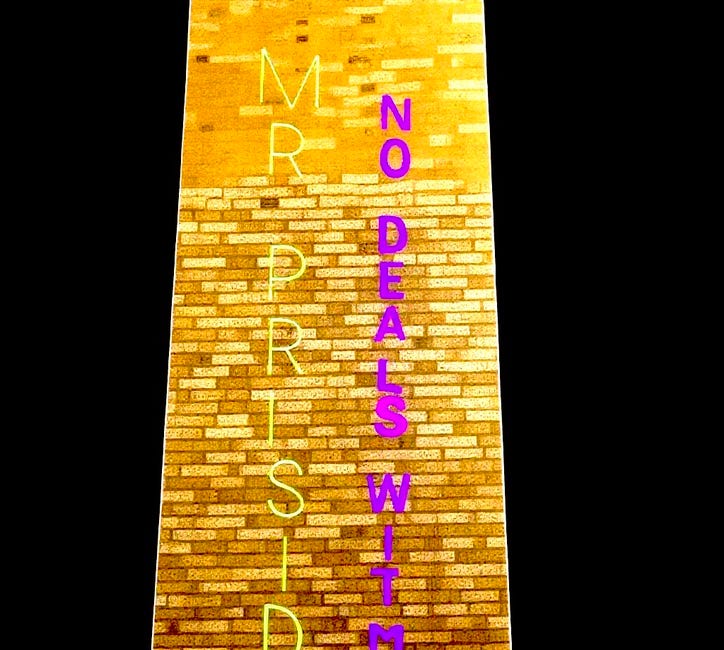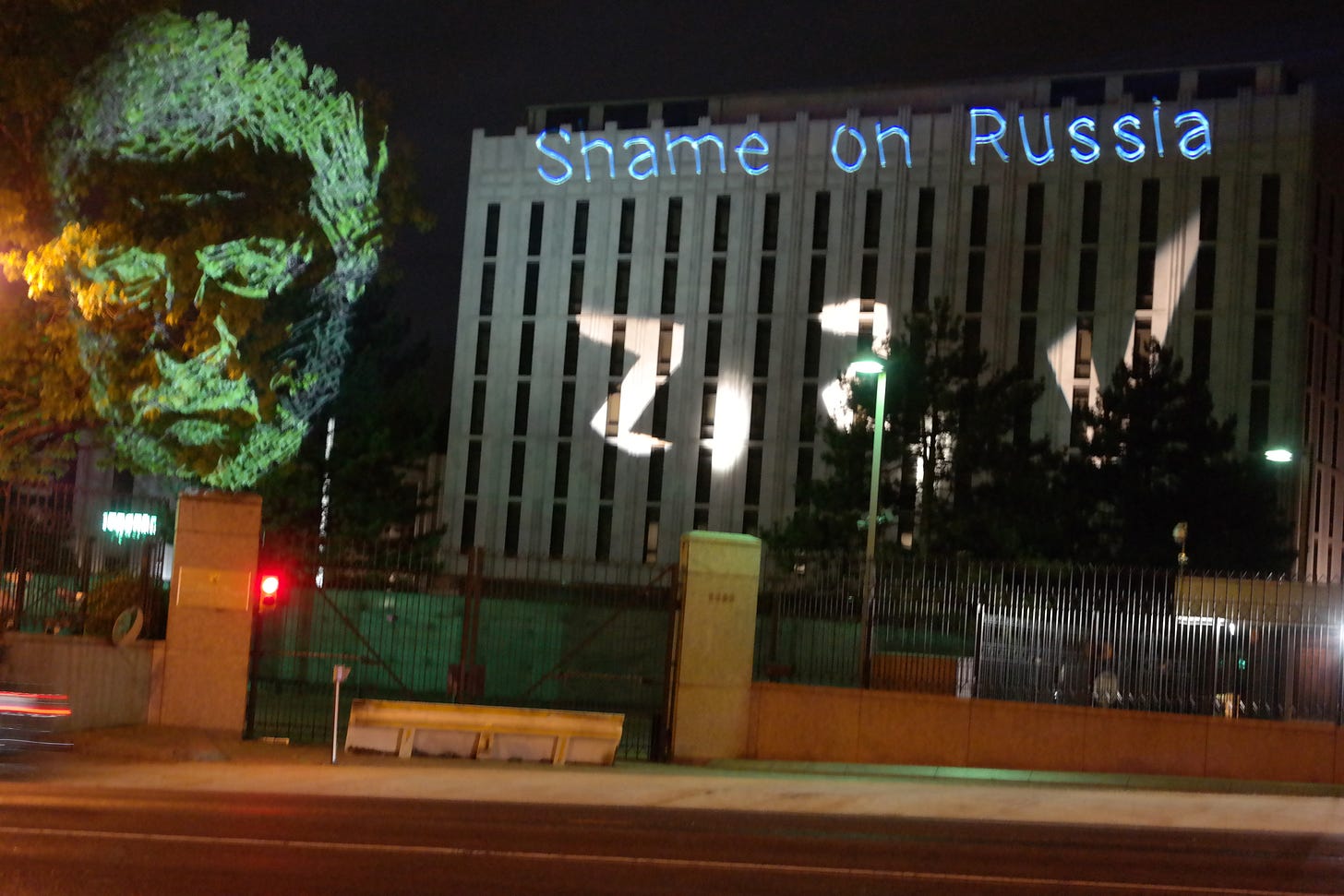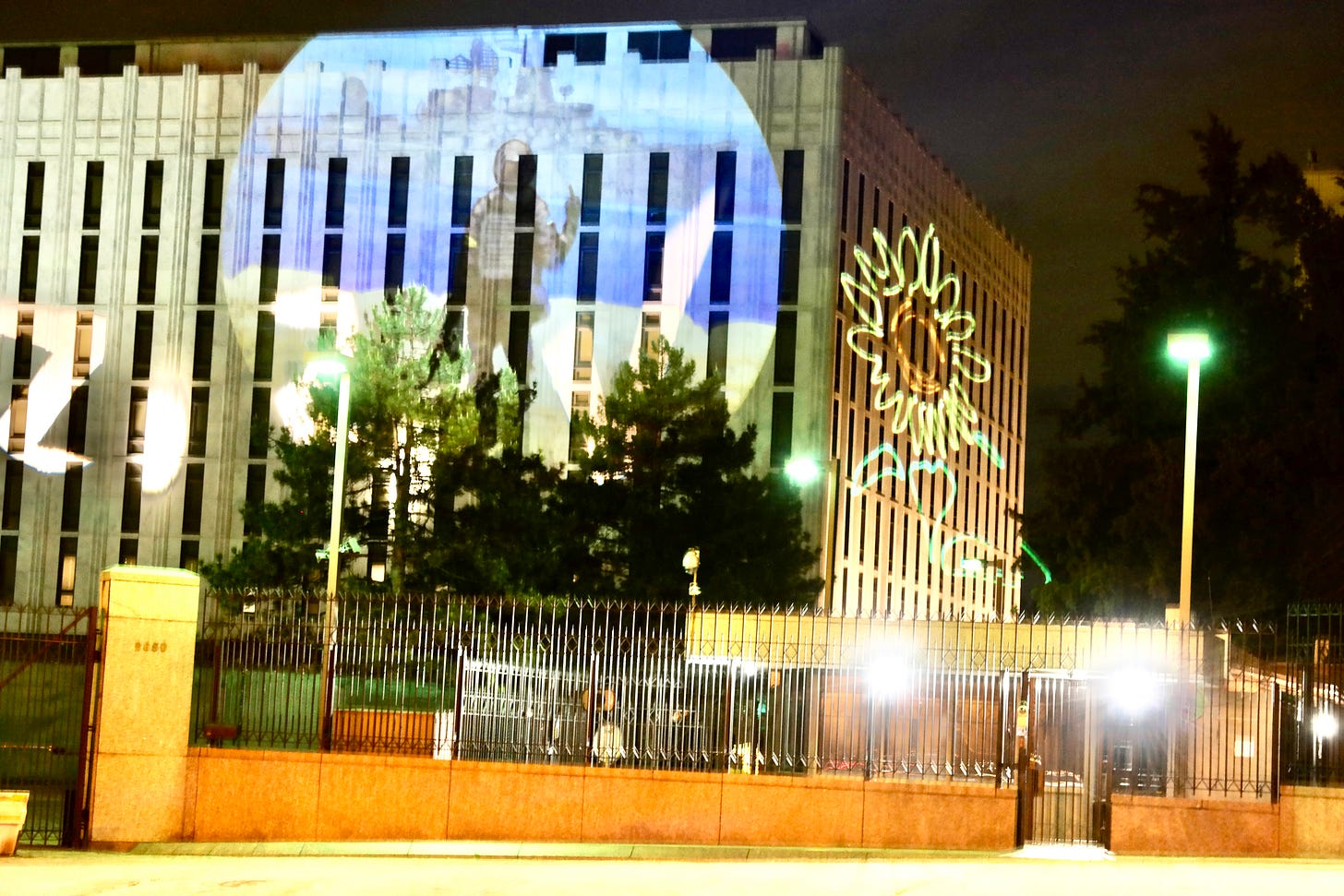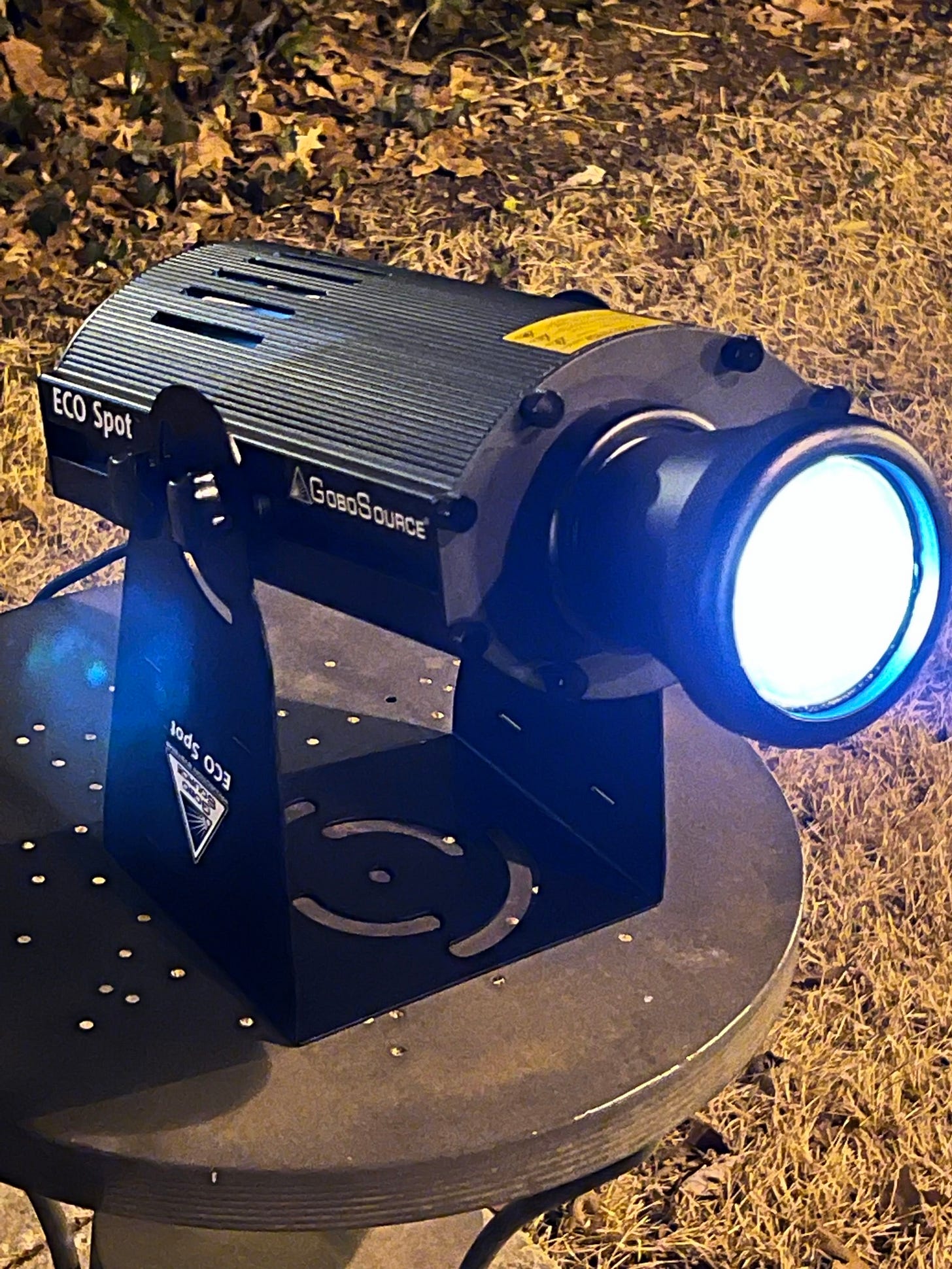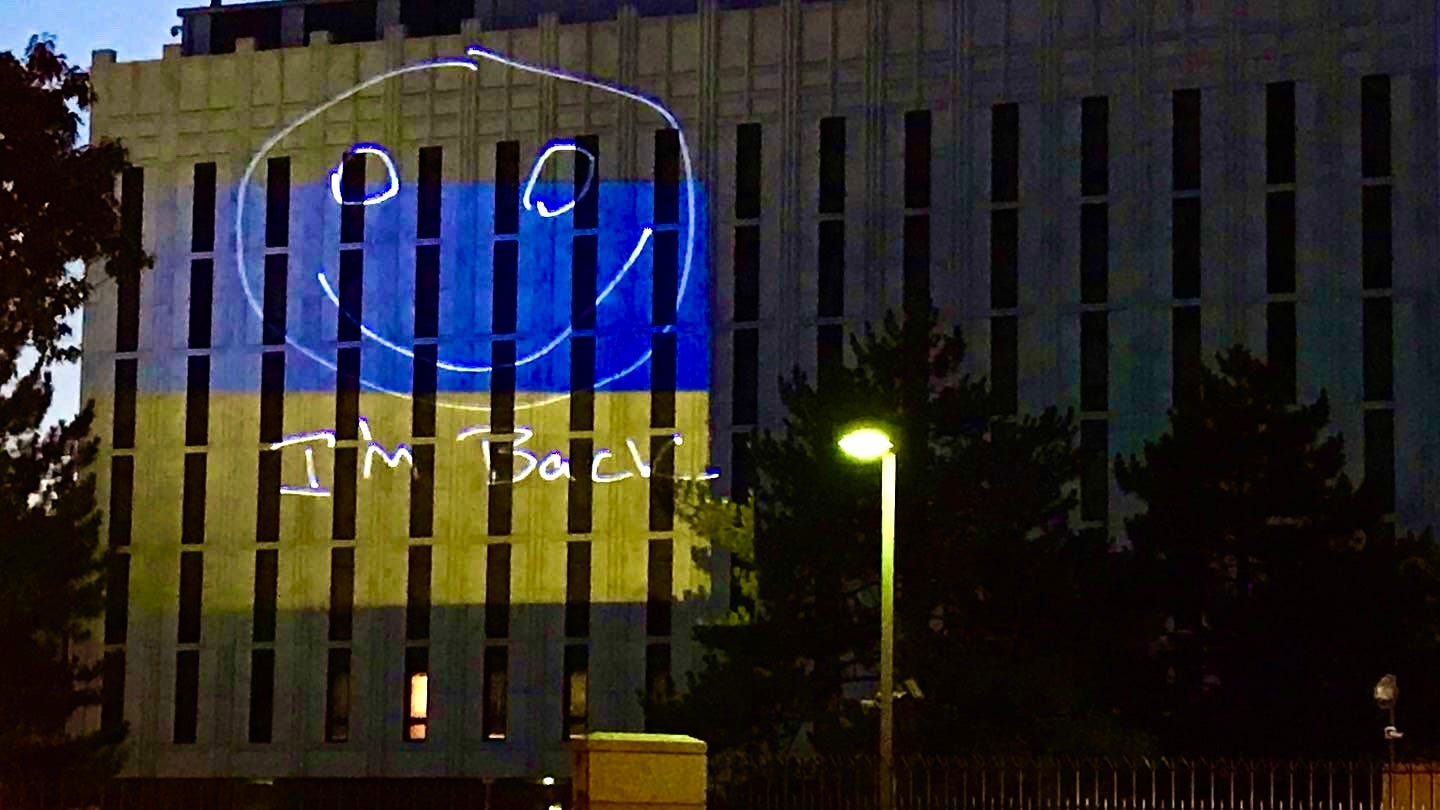Projection Protests: A How-To Guide, Part II
Choosing Gear
Good Morning:
I mentioned yesterday that the most estimable Nikita Titov—a Ukrainian artist with whom I have worked on projections—made a design out of my name in response to the, uh, late unpleasantness. Here it is.
A word of explanation for those for whom Ukrainian symbology is still mysterious. For starters, the coloration is in blue and yellow, the colors of the Ukrainian flag. My first name requires no explanation. “Benjamin” is visible prominently. The design, however, is both a “W”—for Wittes—and a tryzub, the traditional coat of arms of Ukraine:
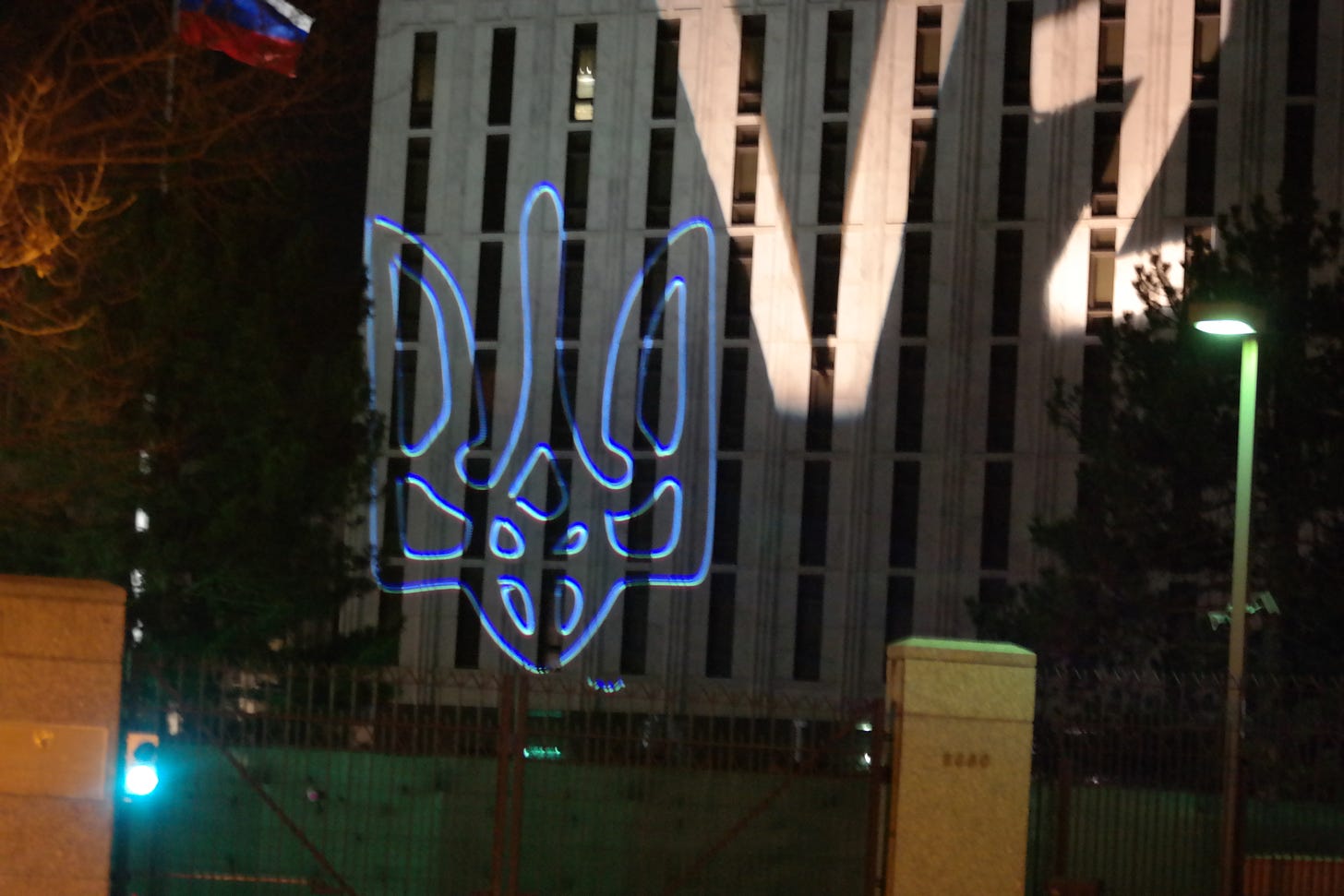
Titov does a lot of work with tryzub-based designs. Here are a few that I have projected:
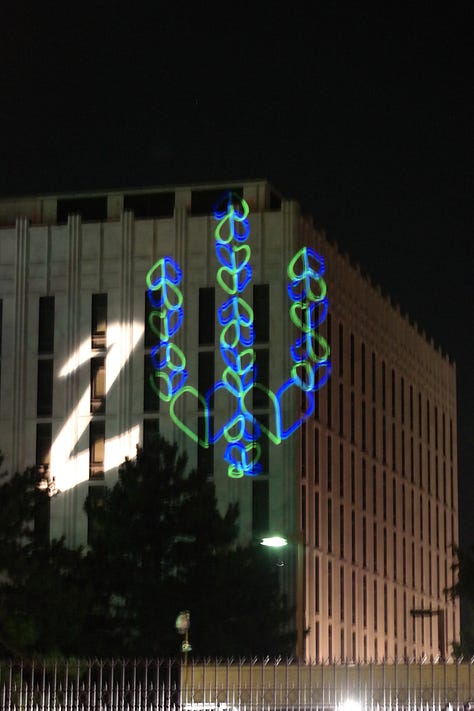
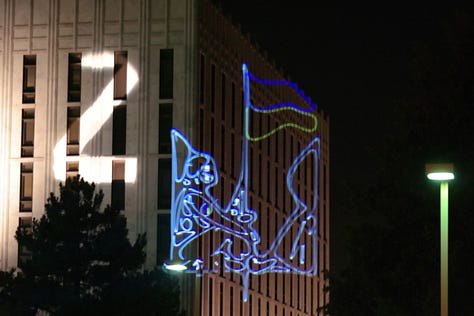
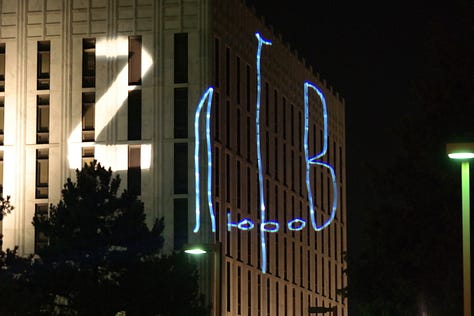
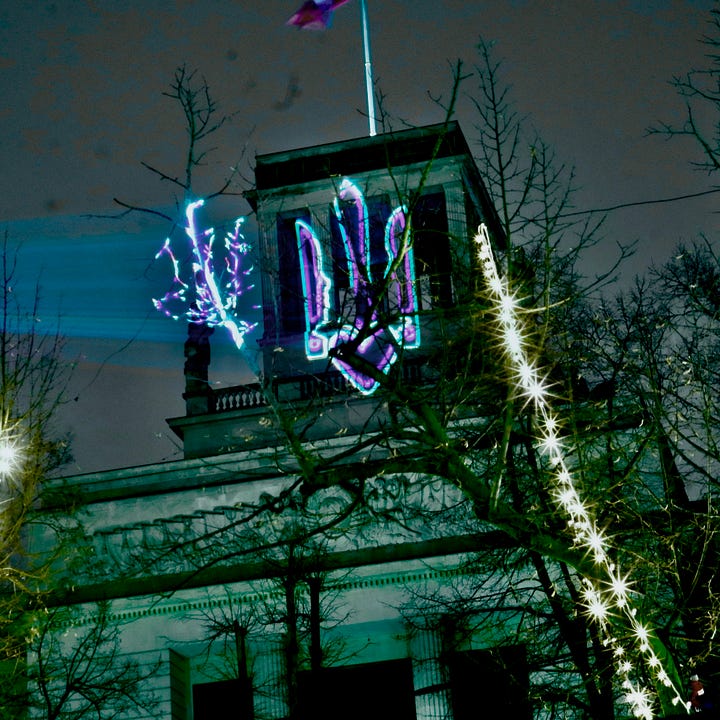
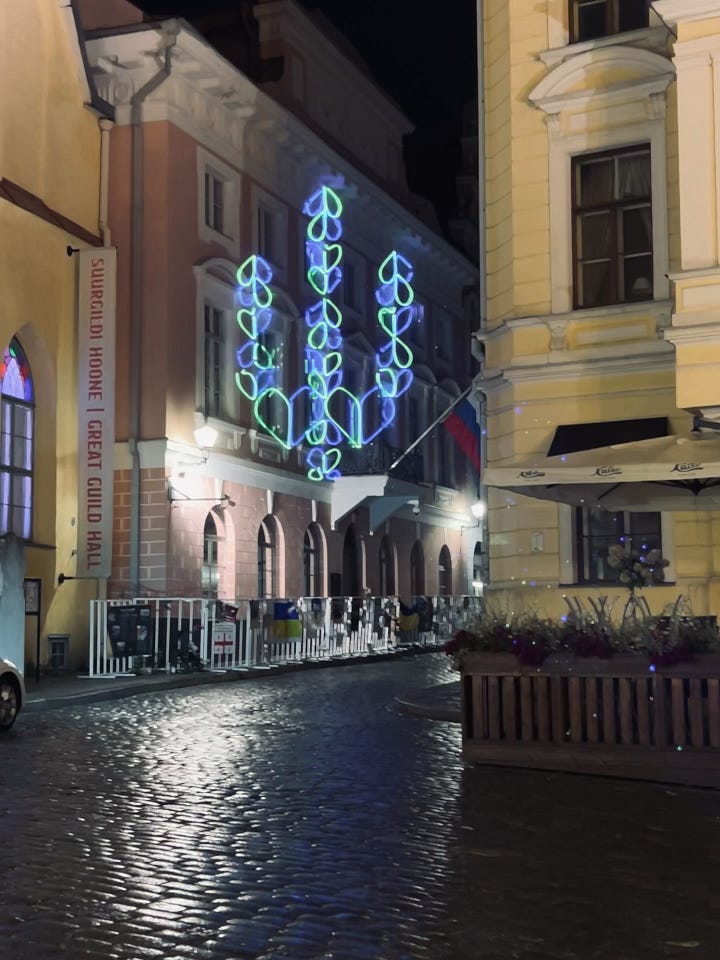
I could not feel more honored to have my name be among these images.
In yesterday’s dog shirt, I talked about target selection:
Today we are going to talk a little bit about gear.
The first thing to say about gear is that your choice of gear is almost wholly derivative of your choice of target and message. If you can get right up close to your target, you might choose to use a standard high-power projector. And then you have the option of projecting things like videos. This is really fun, but it’s also highly condition-dependent. You cannot do it effectively with a “throw distance” of more than a few yards.
If you’re set back the length of a football field, as I am at the Russian embassy, you can’t use a regular projector. It just won’t work well. Trust me. Don’t try it. You’re going to want to use either a spotlight with a gobo (defined below) or you’re going to want to use a laser. Each gear setup has advantages and disadvantages. But the point is that there’s a reason I talked about target selection before gear. You need to figure out as precisely as possible what you’re trying to do before you try to figure out what equipment you want to use to do it.
As a general matter, there are three major considerations (and a bunch of minor ones) you want to consider in choosing projectors. The first is size and weight. In the first Special Military Operation, we used literally a whole vanload of lighting equipment: more than a dozen spotlights (only one of them with a gobo) and multiple generators, and we had to take over the roof of a building near the embassy (about which the management of the building was none too pleased) in order to house it all:
Okay yeah, it was super-fun. But exactly one thing worked well in all of it, and that was the one spotlight with the Ukrainian flag gobo. In the years since, I have iterated and iterated to downsize the production, to make it possible to do more with lighter and lighter weight. I can now do an operation as effective as that original one with a single projector that fits in a small case that I can carry on a flight, one tripod, and one iPhone.
In other words, ideally, one wants to keep size and weight to a minimum.
The flip size of this coin is that one wants to maximize power, which often requires size, which comes with weight. Power equates to the ability to throw images and text over longer distances. It equates to brighter rendering. It also yields images that are more resistant to tampering by pesky “Z” and “V” spotlights.
And then there’s flexibility. All the power in the world doesn’t do you much good if the adversary parks a van in front of your projector and you can’t move it. When I started using lasers, I was amazed at how liberating it was to be able to write on the embassy’s walls with text. Before that, I was working entirely with images. With lasers, I could do a combination of images and writing. That turned out to be enormously powerful.
But flexibility works the other way as well. Lasers raise major safety concerns. They can’t project photographs or even drawings with shaded or colored areas—only lines. By contrast, a big bulky projector can be blocked by a van, but unencumbered, it can project a whole movie. So you’re looking to maximize flexibility to do the things you want to do and to avoid the kinds of interference you anticipate.
With that as background, let’s go through in some detail the general categories of projectors I have used in protests and talk about their pros and cons:
The first is just your garden variety digital multimedia projector. There are a number of different types of multimedia projector, and I’m not going to go into the differences here. (The only thing to note is that some are called “laser projectors,” but should not be confused with the projectors I discuss below as “lasers.”) Think of these as your basic classroom or theater projector. They vary enormously in cost and power—from a few hundred dollars to many tens of thousands dollars.
When you’re dealing with a close-up target wall, a good projector, driven by a laptop computer, is the gold standard. Here, for example, is a projection some colleagues of mine did on the National Gallery using a standard digital projector. It was glorious—until, that is, the National Gallery police asked them to stop:
The professionals of projection arts use arrays of high powered projection to do incredible stuff called “projection mapping.” In my humble opinion, the world’s greatest projection artist is a woman named Julia Shamsheieva—from Ukraine, incidentally—who did this piece of work on a bank at a projection arts festival in New York state.
This gives you a sense of what you can do with an array of eight or ten high-power projectors at close range if you know you will have no interference. It is exquisitely precise.
And you’re not going to do anything like it.
In a protest situation, you generally can’t bring ten perfectly positioned projectors to the party and drive them right up to the wall you want to work with and expect no interference from the opposition.
We don’t get to be Rembrandt. We have to be Banksy.
And for Banksy-type work, the digital projector is a mixed bag. It can still be a great tool if you can get right up close. But you need a lot of power (7,000 to 10,000 lumens for many applications is a good rule of thumb). And that kind of power is expensive. It is also heavy. And it requires generators or a good stable power supply to drive it.
I have had some good results with multi-media projectors and I certainly wouldn’t discourage their use:
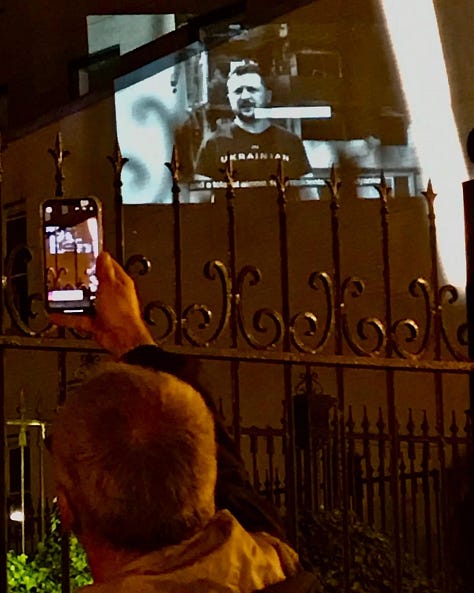


The more I have worked in this space, however, the less I have used them. The reason is that digital projectors are hard to improvise with. They are easy to interfere with: A single spotlight drowns them out. They are expensive. And they cannot throw far.
So here’s my bottom-line advice on multimedia projectors. Use them when all of the the following conditions are met:
The atmosphere is permissive and you control the territory and are not going to have opposition.
The target wall is not well lit, and there is minimal street light.
You can get close to the target.
You can bring your own power supply.
If all of these conditions are present, a projector is the right instrument for the job. But bring one with a lot of power—more than you think you need. These can be rented sometimes at reasonable cost. There are also some good cheaper models that overperform. But especially given light pollution on streets, don’t think you’re going to light up a building like it’s Times Square without spending hundreds of thousands of dollars.
And remember: those gorgeous projections that Shamsheieva does? You can screw them up with a few flashlights. These are the easiest operations to defend against.
This brings me to gobo projectors. A gobo is a little slide disk that fits inside a spotlight, effectively turning a spotlight of whatever power into a slide projector. Gobos can be made of steel and thus project in one color, like this image of Ukrainian President Volodymyr Zelenskyy I projected into the tree on the Russian embassy grounds:
They can also be multicolored, like my Ukrainian flag gobo, or even this print of the famous Snake Island “Russian Warship Go Fuck Yourself” stamp:
A good gobo projector produces much more power than a multimedia projector per unit cost. Much.
I did both of these projections, for example, with the dearly departed Himar the Gobo Projector, who was killed in combat after a year of valiant service (may she rest in peace).
Himar looks like this, weighed 13 pounds, making her remarkably agile. And she was not especially expensive. Which gobo projector you need depends almost entirely on how far you want to throw an image. Himar cost me about $1,500. When I replace her, I will spend a bit more. To put the Snake Island stamp on the Russian embassy with a standard projector would cost at least ten times that—maybe a lot more. And you can spent a lot less on a gobo projector if your throw distance is short:
So the advantages to gobo projectors is that (1) unlike lasers, they can do complex images; (2) unlike standards projectors, they are quite light and agile, and (3) they can throw long distances for reasonable amounts of money.
There are only two real disadvantages to gobo projectors. The first is that the images are necessarily static. If you’re thinking about video or animation, this isn’t a technology that will work.
The second is that each image has to be crafted individually. A steel gobo is not expensive. A full color gobo will run a few hundred dollars, however. So building up a library of them can get pricey. Also, switching them out can be a pain in the ass if the projector doesn’t have a rotator of some kind.
When I get my next gobo projector, it will be a 300 watt unit with a rotator. I expect it will cost about $3,000. But for many protest applications not at the Russian embassy in Washington, that’s more than you need. You can do it for $500.
In short, if you want to project a flag or a single statement or a single image, this is definitely the way to go. Gobo projectors are bright. They are relatively inexpensive. They can traverse long throws and they can cast arrestingly beautiful images. Gobos are also easy to make and order. And the whole technology is delightfully analog. A good gobo projector is not subject to enemy hacking. It’s just a lamp.
This brings us to lasers.
I got interested in lasers for three reasons: First, I wanted to write on the embassy walls. I wanted to be able to stand in back of crowd chanting something and write on the walls whatever they were chanting—and shift when they shifted. I wanted to be able to put a grinning smiley face on top of the gobo projected-Ukrainian flag and tell the motherfuckers: “I’m back.”
I also wanted to travel. I wanted to be able to travel to other Russian embassies in other countries. I wanted something that could fit in carry-on luggage. And I wanted infinite agility, the ability to flick my wrist and rescue a map of Ukraine from a giant “Z.”
Meet #LordLaser. There are serious safety issues associated with lasers. They can blind people and they can pose a threat to aircraft. And these concerns have been weighing on me of late, for reasons I will go into in a future post.
That said, #LordLaser, which is actually called a LaserCube 2.5 watt, is one of the most extraordinary pieces of equipment I have ever worked with. He weighs less than 4 lbs. He is rechargable, and his battery will run for two to four hours, depending on conditions. He fits comfortably in the overhead bin, making him perfect for trips abroad. And he can throw over very long distances.
His spouse, #LadyLaser, is even more powerful. She is the LaserCube 7.5 watt model. She is more expensive. And for all but the most difficult circumstances, the marginal value of the extra power is limited. But in those most difficult circumstances, the power difference is decisive. The Russian spotlights, for example, are useless in drowning out #LadyLaser, even after 300 feet of throw. She dominates. And that’s freakin’ fabulous.
Here is what lasers are good for:
Agility
Text
Distance
Adversity
This last point is critical. Laser light is so powerful and so intense that it is very hard to drown it out. When I project on the embassy with #LordLaser and #LadyLaser, there are no effective countermeasures—or at least, the Russians haven’t found any yet.
The ability to project text is also key. It has allowed me to project essays and work with Ukrainians who have things to say that are more complicated than I can put on a gobo. It has also allowed me to improvise simple words or phrases that capture a whole moment—things like this image, seen by millions of people, on the Russian ambassador’s house after the Russians bombed a maternity hospital:
Here are the disadvantages to lasers:
No complex images
While you can do animations, you cannot do video
No photographs
Safety
You have to keep things very simple, and there are real risks.
The bottom line is that there is no perfect tool for all projection operations. What tool you want depends on your target and what you want to say. The single most effective and flexible tool is definitely a laser. But I miss having a gobo projector very much and will replace Himar as soon as can manage it. I will also buy a new projector as soon as I have an operation that calls for one.
Tomorrow, I will talk about how to design a good operation. Every projector operation is different but there are several important constants that do not change. We will go over them.
Yesterday on #DogShirtTV, I shared some more details about the indefinite detention of my lasers. Then the estimable Alicia Wanless, the estimable Holly Berkley Fletcher, and I discussed how to keep an information ecosystem healthy. What does basic information sanitation look like? How do you treat a patient infected with fake news?
Yesterday On Lawfare
Compiled by the estimable Mary Ford
Deploying the D.C. National Guard
Chris Mirasola—amid President Trump’s deployment of 800 D.C. National Guard personnel to take over the capital's policing—explains that the president’s use of these forces in the District relies on outdated and broadly interpreted statutory law, and erodes legal protections against military incursion into domestic affairs.
The president does not, however, have a free hand in how he can use the D.C. National Guard. Congress has specified two circumstances in which the D.C. National Guard may be called into militia service in D.C. I don’t want to overstate the limits imposed by this statutory scheme—the provisions of law here are outdated, incredibly broad, and have been interpreted broadly by the executive branch for decades. But they’re noteworthy at least to show why statutory change is so urgently needed.
The most straightforward statute authorizing operational deployment of the D.C. National Guard is § 49-103 of the D.C. Code. It authorizes the president to deploy the D.C. National Guard to aid in enforcing the laws when “a tumult, riot, mob, or a body of men acting together by force with attempt to commit a felony or to offer violence to persons or property, or by force or violence to break and resist the laws, or when such tumult, riot, or mob is threatened.”
How Congress Can Engage the American Public on Foreign Policy
Andrew Kenealy argues that legislators can use three informal strategies to amplify congressional influence over public opinion and in turn, shape U.S. foreign policy matters—issue joint statements; message on policy, not the president; and proactive position-taking.
However, Congress has a series of informal tools at its disposal to shape foreign policy. Although a Republican-dominated Congress wouldn’t permit serious investigations into Trump’s foreign policy conduct, Fulbright’s Vietnam hearings illustrate a broader point: Congressional engagement with the American public can mold foreign policy. Congressional messaging on foreign affairs issues is consequential because it can shape public opinion, influencing the contours of U.S. foreign policy in the long run. Crucially, speaking up on foreign policy is relatively straightforward. Unlike formal tools, issuing a message does not require holding majority status, or achieving constitutionally allocated levels of consensus. Any legislator, at any time, can make a compelling statement on a foreign relations issue. And these statements can matter.
Liberal Democracies Are Retreating From AI Safety
Jakub Kraus evaluates the Group of Sevens’s recent Statement on AI for Prosperity and the impact of the second Trump administration on liberal democracies’ artificial intelligence (AI) policies. Kraus cautions that deemphasizing AI safety is a gamble that could make multilateral cooperation on the matter more difficult in the future.
Given this recent history, the 2025 AI prosperity statement marks a significant pivot away from earlier consideration of AI’s risks toward an almost exclusive focus on its benefits. This change is emblematic of a broader recalibration in how liberal democracies approach AI policy across many international forums, from the French AI Action Summit to the Munich Security Conference. Several forces are driving this transatlantic pivot—chief among them the Trump administration’s influence, as well as geopolitical competition, industry pressure, and AI’s growing track record of success.
The CCP’s Legal Warfare Against Taiwan’s Democracy
In the latest installment of Lawfare’s Foreign Policy Essay series, KaiChieh KJ Hsu details the covert tactics—including espionage and bribery—that Beijing is using to undermine Taiwanese democracy, and proposes that Taipei both strengthen its legal defense doctrine and use elements of U.S. law as a model to protect against Chinese lawfare and democratic erosion.
Taiwan must evolve from “national security as exception” to “national security as structure.” This requires not only better laws but also a new mindset: that the war has already begun, and that law is both a weapon and a shield. For Taiwan—and its democratic allies—learning to fight in the legal domain is no longer optional; it is existential. The U.S. experience in defending democracy through legal resilience, rule-of-law countermeasures, and institutionalized oversight offers a valuable reference for democratic societies facing authoritarian lawfare.
Podcasts
On Lawfare Daily, I sit down with Anna Bower, Roger Parloff, and Peter Harrell to take stock of the legal challenge to President Trump’s International Emergency Economic Powers Act tariffs, the D.C. Circuit’s decisions to vacate Judge James Boasberg’s probable cause of contempt by the Trump administration, and the ongoing legal battle in Texas over the Democratic lawmakers who fled the state to prevent Republican efforts to redistrict it.
Announcements
Lawfare is hiring a new associate editor. Applications will be considered on a rolling basis. The deadline to apply is Sep. 2, 2025. Learn how to apply here.
Lawfare is hiring a Fall 2025 editorial intern. Applications will be considered on a rolling basis. The deadline to apply is Aug. 17, 2025. Learn how to apply here.
Today’s #BeastOfTheDay—nominated by the estimable Steve Beckwith—is the cockatoo, seen here meeting yet another cactus operative.
In honor of today’s Beast, hello.
Keep reading with a 7-day free trial
Subscribe to Dog Shirt Daily to keep reading this post and get 7 days of free access to the full post archives.





